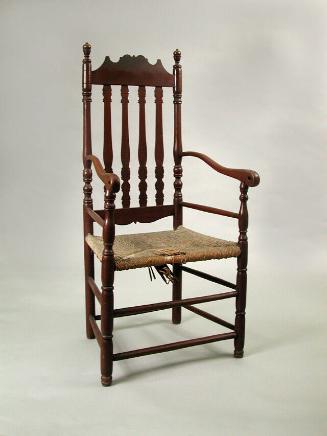Armchair
Original OwnerPossibly originally owned by
Governor Joseph Talcott
(American, 1669 - 1741)
Original OwnerPossibly originally owned by
Samuel Talcott
(American, 1711 - 1797)
Furniture MakerPossibly made by
Spencer Shops
(American)
Date1740-1760
MediumMaple, ash, rush
DimensionsPrimary Dimensions (overall height x width x depth): 46 15/16 x 23 9/16 x 23 1/2in. (119.2 x 59.8 x 59.7cm)
ClassificationsFurniture
Credit LineMuseum purchase
Object number1983.84.0
DescriptionMaple armchair in the William and Mary, or early baroque, style, with a solid crest rail, a banister-back, turned stiles, banisters, front legs, and stretchers, and a rush seat. The back of the chair is formed by a crest rail at the top between two turned stiles; each stile has a ball-shaped finial at the top. The top of the crest rail is shaped with an arch, flanked by a lobe and a tapered edge. Below the crest rail are four cone-and-reel turned banisters, which attach at the bottom to the stay rail. The banisters are turned and split; the rounded side of each banister faces the front of the chair. The lower edge of the stay rail is shaped with a downward pointing peak flanked by an upward curve with a chamfered edge, ending in a circular scroll near each stile. Above the seat, each stile is turned and is angled backward. Below the seat, each stile forms a straight back leg and foot. Each arm slopes downward and has a scrolled handhold that extends well past the top of each front leg. The top surface of each arm and handhold is rounded. Each front leg is turned with a baluster over three blocks, each separated by ovoid turnings, over a Spanish foot (now missing). Above the seat, each front leg supports the arm. The chair has a trapezoidal rush seat. Each side of the chair has a turned baluster-and-ring stretcher below the arm and above the rush seat, connecting the upper portion of the front leg to the stile at the back. The front, sides, and back of the chair each have one stretcher; these stretchers are each turned with a double-baluster form.
Painted Decoration (later addition, now worn): The armchair has gilded decoration over a brown mahoganized, or grained, finish. The gilded decoration circles many of the turned rings on the stiles, banisters, front legs, and stretchers. Most blocks have a gilded border outlining the front.
Condition: The front and back feet are missing. The chair is not structurally sound; the joints where the side seat rails and arms join the stiles are loose. The rush seat is damaged, and a portion of the rush is missing to the right of the middle of the front seat rail. The banisters, arms, handholds, and front ankles are worn and scratched. The chair has been faux grained with gilded decoration; the graining and decoration are now scratched and worn.
Design and Construction Details: The crest rail has a rectangular tenon at each side that extends into the block near the top of each stile; each of these joints is secured with a wooden pin through the back. Each banister is constructed of a split spindle. Each banister is tenoned into the crest rail at the top and into the stay rail below. Each end of the stay rail has a rectangular tenon that extends into the stile. Each arm is tenoned and pinned into the stile at the back. Each front leg is tenoned and pinned into the front of the arm above. Each seat rail is bladelike, with a rounded outer edge and a tapered inner edge. The seat rails and stretchers have round tenons that extend into the front or back legs.
Painted Decoration (later addition, now worn): The armchair has gilded decoration over a brown mahoganized, or grained, finish. The gilded decoration circles many of the turned rings on the stiles, banisters, front legs, and stretchers. Most blocks have a gilded border outlining the front.
Condition: The front and back feet are missing. The chair is not structurally sound; the joints where the side seat rails and arms join the stiles are loose. The rush seat is damaged, and a portion of the rush is missing to the right of the middle of the front seat rail. The banisters, arms, handholds, and front ankles are worn and scratched. The chair has been faux grained with gilded decoration; the graining and decoration are now scratched and worn.
Design and Construction Details: The crest rail has a rectangular tenon at each side that extends into the block near the top of each stile; each of these joints is secured with a wooden pin through the back. Each banister is constructed of a split spindle. Each banister is tenoned into the crest rail at the top and into the stay rail below. Each end of the stay rail has a rectangular tenon that extends into the stile. Each arm is tenoned and pinned into the stile at the back. Each front leg is tenoned and pinned into the front of the arm above. Each seat rail is bladelike, with a rounded outer edge and a tapered inner edge. The seat rails and stretchers have round tenons that extend into the front or back legs.
Status
Not on view












